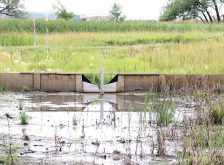Installing drainage tile on farmland comes with a hefty price tag, costing anywhere from $900 an acre up to $1,400 an acre or more by some estimates. Like for any large capital expense, producers need to weigh the decision carefully before moving ahead with this kind of project.
Ultimately it comes down to dollars and cents — will tile drainage make your farm more profitable? To answer that question, Brett Sheffield says you need to start by identifying and assessing yield constraints on your farm.
- Read more: When is tile drainage a good fit?
Read Also

Claas brings 1000 Series SP forage harvesters to Canada
In mid-August, Claas unveiled its new line of Jaguar forage harvesters at an event in Visalia, California, deep in the heart of that state’s dairy region.
Sheffield is a Manitoba entrepreneur who started his own tile installation company, NextGen Drainage Solutions, in the small farming community of Pilot Mound in 2012. Sheffield’s farming background and business acumen has helped his firm become one of the largest tiling contractors in Western Canada.
Sheffield grew up on a farm in the Pilot Mound area and studied tile drainage and subsurface irrigation at universities in Ontario and Ohio as well as the University of Manitoba. He was still in university when he thought he’d try tiling some unproductive acres on the family farm. When it turned into one of the farm’s most profitable fields, Sheffield knew he was on to something that could help other farmers boost their bottom lines too.

What’s limiting your yields?
Weather is a huge factor, of course, but lots of other things can cause low-yielding crops. Sheffield says it’s important to consider the biggest yield-limiting factor on your farm, and if it’s something like disease, saline soils, delays in planting or a lower-than-expected grade for your crop, this often stems from “too little water or too much water at the wrong time,” which is the central problem tile drainage is meant to fix.
Removing excess water is an obvious payoff for tile drainage. Submerged fields and saturated soils can slash yields, cause salinity problems and even spell the loss of an entire crop, if it’s bad enough.
This is a growing concern for many producers in Western Canada, who are starting to see bigger rainfall events rather than the smaller, more frequent ones that are becoming less common, Sheffield notes. He says part of the value tile brings is it helps farmers manage risk by draining fields quickly during wet periods (and wet years) to reduce crop loss.
Sheffield maintains when tiles are installed properly, in the right areas and at the right depth, they remove excess water that is harmful to root growth but will still maintain adequate soil moisture levels. “We’re not putting it down too deep so that it takes out too much water.”
By regulating water levels in a field, Sheffield says, tile drainage can enable farmers to start seeding sooner.

In a 2019 blog, Farmers Edge agronomist Thom Weir wrote early seeded crops generally produce higher yields. Other benefits include heavier, higher quality grain from cereals, higher quality for pulses and higher oil content from oilseeds. Weir also noted early seeding can provide a wider window of opportunity for timely weed control and can also mean earlier harvesting.
Agronomic benefits
Sheffield maintains another way tiling can improve profitability is through agronomic benefits that produce healthier, higher yielding plants. By balancing water, mineral and oxygen levels in the soil, drainage tile creates an optimal environment for young plants to grow deeper roots and become better equipped to deal with stressors like disease and drought that can come up during the season, he says.
“You’re controlling your top three feet of your soil to make sure that roots are going to start off healthy and plants can thrive,” says Sheffield. He adds having longer roots enables the plants to tap into a lower water table during the hot summer months when soils tend to dry out.
Olaf Boettcher of Precision Drainage Solutions in Saskatoon, Sask., says another benefit of tile drainage is it reduces surface runoff and increases water filtration into the soil.
“It improves your soil tilth and soil structure, so your roots go deeper, sooner in the season and make more (drought-resistant) plants. You get a deep root system early and it gives the plant access to more nutrients and water,” he says.
Boettcher and Sheffield agree one of the really valuable things about tile drainage is it can help farmers looking to increase their productivity — and profitability — without having to expand their land base. By adding to the number of arable acres within their farms, producers don’t need to purchase additional farmland, which, of course, can be very expensive.
Sheffield says the cost of tile drainage will vary widely from farm to farm, but he believes producers can generally expect to see anywhere from “a three-year payback to a 10-year payback” as a return on investment.
Because of the expense involved, most farmers will start with one field or area that would benefit the most from tile drainage, and then add acres over time rather than going all-in right away.
Count Manitoba grain farmer Dustin Williams as one of them. He got NextGen Drainage Solutions to install tile in an unproductive (and frequently flooded) field last fall and he plans to have them tile more acres on his farm near Souris, Man., in the coming years.
Williams is obviously sold on the idea of tile drainage, and he believes taking a gander at the yield monitor on your combine is really all it takes to realize its value.
“With my land, it’s very apparent where I have water issues, and the more I watch my yield maps, the more I realize that the vast majority of my (yield) losses in a given year are actually because of poor water management,” he says.
“I know that it’s because water is sitting here. It’s causing salinity, it’s causing kochia, it’s causing a decline in plant health, an increase in root rots — all of those things. They all have a big influence on the final numbers.”















